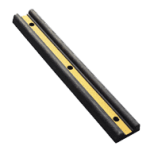Reduced Speeds and Increased Safety
Speed Bumps Force Drivers to Slow Down
Speed bumps are an effective way to slow down drivers in areas where speed limits are often ignored. By forcing drivers to slow down, speed bumps can reduce the risk of accidents and improve safety for pedestrians and cyclists. Additionally, speed bumps can help to reduce noise pollution and improve air quality by encouraging drivers to drive more slowly and smoothly. While some drivers may find speed bumps to be an inconvenience, the benefits of installing them in high-risk areas far outweigh any minor inconvenience they may cause.
Fewer Accidents and Injuries
Speed bumps are an effective way to reduce the number of accidents and injuries on the roads. By forcing drivers to slow down, speed bumps can prevent collisions and reduce the severity of accidents that do occur. This is particularly important in areas with high pedestrian traffic, such as school zones and residential neighborhoods. In fact, studies have shown that the installation of speed bumps can lead to a significant reduction in the number of accidents and injuries on the roads. By making our streets safer for everyone, speed bumps can help to improve the quality of life in New York City.
Pedestrian Safety Improvements
Pedestrian safety is a top priority in New York, and installing speed bumps can greatly improve safety for those walking in the city. Speed bumps force drivers to slow down, reducing the risk of accidents involving pedestrians. Additionally, speed bumps can be placed in areas where there are high volumes of foot traffic, such as near schools or parks, further increasing safety for pedestrians. By installing speed bumps, New York can take a proactive approach to pedestrian safety and create a safer environment for all residents and visitors.
Traffic Calming and Noise Reduction
Reduced Traffic Congestion
Reduced Traffic Congestion: One of the most significant benefits of installing speed bumps in New York is the reduction of traffic congestion. Speed bumps force drivers to slow down, which helps to prevent accidents and improve traffic flow. When drivers are forced to slow down, they are less likely to tailgate or engage in other aggressive driving behaviors that can cause traffic jams. Additionally, speed bumps can help to reduce the number of cars on the road by discouraging drivers from using certain routes. This can be particularly helpful in areas where traffic is already congested, as it can help to alleviate some of the pressure on the roadways. Overall, the installation of speed bumps can be an effective way to reduce traffic congestion and improve the overall safety and efficiency of New York’s roadways.
Less Noise Pollution
Less Noise Pollution: Speed bumps can also help reduce noise pollution in residential areas. When vehicles are forced to slow down, they produce less noise, which can be a significant benefit for those living near busy roads. This reduction in noise pollution can lead to a more peaceful and comfortable living environment for residents. Additionally, less noise pollution can have positive effects on mental health, as excessive noise can cause stress and anxiety. By installing speed bumps in New York, the city can take a step towards creating a quieter and more peaceful environment for its residents.
Improved Quality of Life for Residents
Speed bumps New York not only improve safety on the roads but also have a positive impact on the quality of life for residents. With reduced speed limits, noise pollution from speeding vehicles is significantly reduced, making the streets quieter and more peaceful. Additionally, speed bumps can encourage more people to walk or bike, promoting a healthier and more active lifestyle. This can also lead to a stronger sense of community as residents are more likely to interact with each other while walking or biking. Overall, the installation of speed bumps can greatly enhance the livability of a neighborhood and improve the well-being of its residents.
Cost-Effective Solution
Low Installation and Maintenance Costs
One of the major advantages of installing speed bumps in New York is the low installation and maintenance costs. Compared to other traffic calming measures, such as roundabouts or traffic circles, speed bumps are relatively inexpensive to install. Additionally, they require minimal maintenance, as they are made of durable materials that can withstand heavy traffic and harsh weather conditions. This makes speed bumps a cost-effective solution for improving road safety and reducing speeding in residential areas and school zones. With their low installation and maintenance costs, speed bumps are an excellent investment for local governments and communities looking to enhance road safety without breaking the bank.
Long-Lasting and Durable
Speed bumps are not only effective in reducing speed and improving safety on roads, but they are also long-lasting and durable. Made from high-quality materials such as rubber, asphalt, or concrete, speed bumps can withstand heavy traffic and extreme weather conditions. This means that they require minimal maintenance and can last for years without needing to be replaced. Additionally, their durability ensures that they remain effective in slowing down vehicles and preventing accidents, making them a cost-effective solution for improving road safety in New York.
Potential Cost Savings from Reduced Accidents and Injuries
Installing speed bumps in New York can lead to potential cost savings from reduced accidents and injuries. According to a study conducted by the National Highway Traffic Safety Administration, the average cost of a non-fatal injury resulting from a car accident is around $61,600. This cost includes medical expenses, lost wages, and property damage. By reducing the speed of vehicles on the road, speed bumps can help prevent accidents and injuries, ultimately saving money for both individuals and the city as a whole. Additionally, speed bumps can also reduce the wear and tear on roads, leading to lower maintenance costs in the long run.
Environmental Benefits
Reduced Carbon Emissions
Reduced Carbon Emissions: Speed bumps can also contribute to reducing carbon emissions in New York. By slowing down traffic, drivers are forced to accelerate and brake less frequently, which can lead to a reduction in fuel consumption and emissions. Additionally, speed bumps can encourage more people to walk or bike instead of driving, further reducing carbon emissions. This can have a positive impact on the environment and help New York move towards a more sustainable future.
Encourages Sustainable Transportation
Encouraging sustainable transportation is a crucial aspect of modern urban planning. Speed bumps can play a significant role in promoting sustainable transportation by slowing down vehicles and making streets safer for pedestrians and cyclists. When drivers are forced to slow down, they are more likely to notice and yield to pedestrians and cyclists, making it easier and safer for them to navigate the streets. Additionally, speed bumps can encourage people to walk or bike instead of driving, reducing traffic congestion and air pollution. By installing speed bumps in New York, the city can promote sustainable transportation and create a safer and healthier environment for all residents.
Improved Air Quality
Installing speed bumps in New York can also lead to improved air quality. By slowing down traffic, vehicles are forced to operate at a lower speed, which reduces the amount of emissions released into the air. This is especially important in areas with high traffic volume, such as residential neighborhoods and school zones. In addition, speed bumps can encourage drivers to use alternative modes of transportation, such as walking or biking, which further reduces the number of vehicles on the road and improves air quality. Overall, the installation of speed bumps can have a positive impact on the environment and the health of New York residents.








